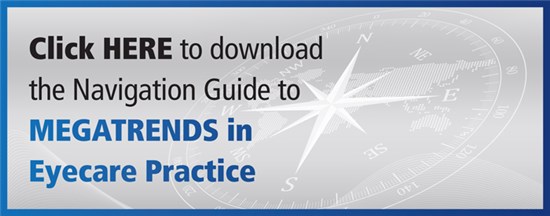Excerpt from the Navigation Guide to MEGATRENDS in Eyecare Practice
By ROB Editors
August 3, 2016
Excerpted from the newly published 2016 version of Vision Source’s Navigation Guide to MEGATRENDS in Eyecare Practice: A 20-page report outlining market forces and consumer behavior affecting the profession now and in the future. Included are implications for ODs and action steps to capture opportunities.
 The role of the OD in healthcare is expanding. This is the result of the expanded scope of optometric practice, enabling ODs to treat a broader range of ocular conditions, as well as the increasing reliance on ODs by managed care companies in early disease detection and ongoing monitoring of patients’ overall health.
The role of the OD in healthcare is expanding. This is the result of the expanded scope of optometric practice, enabling ODs to treat a broader range of ocular conditions, as well as the increasing reliance on ODs by managed care companies in early disease detection and ongoing monitoring of patients’ overall health.
The nearly universal licensing of ODs to prescribe therapeutic pharmaceuticals to treat ocular disease has gradually altered the daily work of ODs, has broadened the range of services ODs can offer patients and opened new revenue opportunities.
The level of involvement in medical eyecare among OD practices varies widely. Most are involved at some level. Some practices now derive more than half of their revenue from medical eyecare and actively market their glaucoma, dry eye, allergy and infection treatment services.
Other practices continue to focus mainly on prescribing corrective devices and treat ocular disease only if a patient presents acute symptoms. Practices that are largely uninvolved in medical eyecare usually refer glaucoma patients to specialists. It is estimated that in typical independent OD practices today, one-in-five patient visits involve medical eyecare. The proportion of medical eyecare patients in OD practices affiliated with optical chains is usually substantially lower. MBA surveys earlier in the decade suggested that medical eyecare accounted for a median of 17 percent of gross revenue in independent OD practices. It’s likely this median share of revenue has slowly increased in recent years. Other studies have shown that many patients suffering from ocular allergies or ocular surface disease remain undiagnosed and untreated because many ODs make little effort to uncover symptoms of these conditions.
ODs are well positioned as gatekeepers of patients’ overall health. The 40,000 ODs practicing in the U.S. have over 100 million patient encounters annually, equivalent to seeing one-third of the population every year. ODs routinely see patients who are unaware of the symptoms of their chronic disease and have not been diagnosed with disease by a primary care physician or specialist. In the course of a comprehensive eye exam, ODs are able to detect common chronic conditions such as hypertension, highcholesterol, metabolic syndrome, and diabetes, as well as lower incidence diseases such as rheumatoid arthritis, multiple sclerosis, Crohn’s disease, Graves disease and others. Once disease is detected during a routine eye exam, patients can be referred to other medical providers for treatment.
Access to ODs often is easier than with other medical providers, and can be less costly. This makes ODs attractive to insurers as health gatekeepers, because early detection is more likely, and long?term costs are thereby reduced. Insurers also consider ODs a more attractive alternative to primary care physicians as gatekeepers of the population’s health because the physician supply is stagnant, even as the number of people seeking medical care grows as insurance coverage expands under the Affordable Care Act.
ODs also can play an expanded role in ongoing monitoring of patients’ disease states. Such monitoring results in earlier intervention, fewer complications and higher patient compliance with treatment plans–all of which reduce long-term costs and improve outcomes.
The Dawn of Data-Based Medicine
Head-spinning advances in the collection and analysis of data are re-configuring many areas of healthcare delivery. Systems like IBM’s Watson are able to process vast amounts of data, including in medicine, where data collected on pathology from all around the world can be crunched in seconds. The promise is that patterns of disease not apparent to the human eye, mind or senses can be detected, followed by treatments that can be devised more readily than in the past. In one recent case, a super-computerwith image-recognition technology was employed to analyze 6,000 scans of diagnosed lung cancer cases—and proved 50 percent more accurate than humans, its producer claims.
These kinds of developments hint at even greater promises to come: A new generation of super-computers—themselves cloud-based—now draw upon far-flung databases and apply artificial intelligence to derive models of problem solving and disease treatment with ever greater accuracy. In recent years, the practice of optometry has moved from data collection to data interpretation. In years to come, optometry will interpret even higher levels of data—with greater potential to improve patients’ lives.
Implications for Optometry
OPTOMETRISTS OFFER INITIAL DIAGNOSES. Increasingly, large insurers and ACOs will accredit panels of optometrists to serve as gatekeepers in coordinated care networks to monitor enrolled patients’ overall health.
ODS WILL NEED TO MAINTAIN ACO RELATIONSHIPS. ODs will need to meet quality?of?care standards imposed by government, insurers and ACOs to gain and maintain accreditation and patient access.
EMPHASIZE MEDICAL EYECARE. A major source of new revenue opportunity for most ODs will continue to come from expansion of medical eyecare services. Medical eyecare is a way for independent ODs to differentiate their services from corporate eyecare providers, whose primary focus is selling eyeglasses.
Action Steps
FOCUS ON DIABETIC CARE. Refine office processes to monitor diabetic patients.
EMPHASIZE GLAUCOMA CARE. Become expert at glaucoma treatment.
EXPAND OCULAR SURFACE DISEASE SERVICES. Develop protocols to screen patients with ocular allergies and ocular surface disease.
MARKET MEDICAL EYECARE. Make patients aware that you offer medical eyecare services.
REFINE CO-MANAGEMENT. Upgrade co-management communication vehicles to share diagnostic findings on chronic disease with primary care physicians
and other providers in coordinated care networks.
INVEST IN INSTRUMENTATION. Enhance instrumentation to enable disease detection.
ADVANCE TO MEANINGFUL USE. Achieve Meaningful Use of EHR.
ALIGN WITH ACOS. Achieve accreditation with local Accountable Care Organizations.

























